Copyright
To obtain a copy of this publication or an alternate format (Braille, large print, etc.), please fill out the Publication Request form or contact:
Web Services Centre
Innovation, Science and Economic Development Canada
C.D. Howe Building
235 Queen Street
Ottawa, ON K1A 0H5
Canada
Telephone (toll-free in Canada): 1-800-328-6189
Telephone (Ottawa): 613-954-5031
TTY (for hearing-impaired): 1-866-694-8389
Business hours: 8:30 a.m. to 5:00 p.m. (Eastern Time)
Email: ISED@canada.ca
Permission to Reproduce
Except as otherwise specifically noted, the information in this publication may be reproduced, in part or in whole and by any means, without charge or further permission from the Department of Industry, provided that due diligence is exercised in ensuring the accuracy of the information reproduced; that Industry Canada is identified as the source institution; and that the reproduction is not represented as an official version of the information reproduced, nor as having been made in affiliation with, or with the endorsement of, the Department of Industry.
For permission to reproduce the information in this publication for commercial purposes, please fill out the Application for Crown Copyright Clearance or contact the Web Services Centre (see contact information above).
© Her Majesty the Queen in Right of Canada,
as represented by the Minister of Industry, 2016
Cat. No. Iu188-113/4-2016E-PDF
ISBN 978-0-660-04969-4
Aussi offert en français sous le titre Profil des PME : les emprunteurs dans le cadre du Programme de financement des petites entreprises du Canada, mars 2016.
PDF Version
Christopher Coe
Small Business Financing Program, Small Business Branch
Innovation, Science and Economic Development Canada
Summary:
Introduction
Small and medium-sized enterprises (SMEs) are significant drivers of economic growth and employment within Canada's economy, accounting for 99.8 percentFootnote 1 of all businesses and 90.2 percentFootnote 2 of privately employed individuals. SMEs are also key drivers of job creation, accounting for 95.5 percent of all private jobs created from 2005 to 2015. On average, small businesses created about 100,000 net jobs each year over that period.Footnote 3
One of the most significant determinants of commercial success is access to sufficient and appropriate financing. The Canada Small Business Financing Program (CSBFP) facilitates access to affordable financing for SMEs to establish, expand, modernize and improve their businesses, which ultimately stimulates economic growth and creates jobs for Canadians.
The purpose of this report is to profile the general characteristics of CSBFP borrowers. Understanding the characteristics of these borrowers will provide Innovation, Science and Economic Development Canada (ISED) with an evidence-based approach to addressing the unique challenges they face, and how the program could better meet their financing needs.
Data definitions
This report relies primarily on the Survey on Financing and Growth of Small and Medium Enterprises, 2014; the CSBFP Awareness and Satisfaction Study;Footnote 4 CSBFP administrative data and key small business statistics from Statistics Canada's CANSIM database. For additional statistics on CSBFP borrower characteristics, please refer to the Canada Small Business Financing Act Annual Report or historical data tables, which can be found in the CSBFP Documentation Centre.
Much of the analysis contained in this report is broken down into "CSBFP versus all SMEs." These were two distinct samples in the Survey on Financing and Growth of Small and Medium Enterprises.Footnote 5 All SMEs does not include CSBFP borrowers, allowing for direct comparisons across various characteristics. Thus "all SMEs" can be interpreted as "all other non-CSBFP SMEs." Small and medium-sized enterprises are defined as commercial, for-profit businesses with fewer than 500 employees and that, in 2014, generated $30,000 or more in revenue. Excluded are self-employed and indeterminate businesses. Not-for-profit and public administration organizations, such as schools, hospitals and public utilities, were also excluded from the analysis. This definition should not be confused with CSBFP eligibility, which defines business size by revenue.Footnote 6
1. Overview of the Canada Small Business Financing Program
The CSBFP is a statutory loan loss-sharing program governed by the Canada Small Business Financing Act and administered by ISED. Under the CSBFP, the Government of Canada and financial institutions (which include chartered banks, credit unions and Caisses populaires) share the risk of providing SMEs with term loans for acquiring real property and/or equipment and making leasehold improvements. The government is liable to pay 85 percent of eligible losses on defaulted loans registered under the program. By sharing the burden of risk on loans, the Government of Canada and private sector lenders are able to increase the amount of financing extended to SMEs.
Under the program, a small business can apply for a loan at a financial institution of its choice. Financial institutions provide financing to small businesses operating in all sectors, except agriculture, in all provinces and territories.Footnote 7 Not-for-profit and religious organizations are also excluded. Lenders are responsible for all credit decisions, approving loans, disbursing loan proceeds, registering loans with the CSBFP, administering loans and, in the event of default, realizing on security and guarantees.
CSBFP parameters
Borrower eligibility
Firms with annual sales of $10 million or less are eligible to use the program. Agricultural, charitable and religious organizations are excluded.
Loss-sharing ratio
The government shares in eligible losses after realization on security. Its share of eligible losses for loans in default is 85 percent. Lenders are responsible for the remaining 15 percent.
Eligible expenses
Equipment, real property or immovables, leasehold improvements and program registration fees.
The loan amount cannot exceed $1 million. While the total amount could be used for the purchase or improvement of real property, a maximum of $350,000 can be used for other allowable expenses, such as leasehold improvements, equipment and registration fees.
Maximum financing coverage
The maximum period of government coverage on a CSBFP loan is 15 years for real property and 10 years for all eligible expenses.
2. CSBFP lending trends
In 2014–15,Footnote 8 Canadian small businesses received 5,067 loans valued at $785.3 million. Compared with the previous year, the number and value of loans made were down by 10.6 percent and 8.0 percent respectively (5,667 loans valued at $853.7 million). This is the fourth consecutive fiscal year in which the number and value of loans disbursed have declined compared with the previous year. The average loan size in 2014–15 was $154,975, an increase of 2.9 percent relative to 2013–14, outpacing the rate of inflation. It is expected that this amount will continue to increase as legislative changes made in June 2015 increased the maximum loan amount from $500,000 to $1 million.
CSBFP Trends
Accomodation and Food Services and Retail Trade
Over half of CSBFP borrowers currently operate in the accommodation and food services or retail trade sectors, compared with 37 percent in 1999–2000.
Loan Size
Over the past five years, the average loan size increased at a rate of approximately 4.1 percent, outpacing inflation. The current average loan size of almost $155,000 is expected to increase at an even higher rate following recent legislative amendments that increased the maximum loan amount from $500,000 to $1 million.
Requests for External Financing
The percentage of CSBFP borrowers requesting external financing (defined as any funds obtained from outside of the firm) compared with all other SMEs has been steadily increasing since 2007.
Loan Volume
CSBFP loans have declined for four consecutive years in terms of number and total value. This may be driven by structural changes in the financing needs of entrepreneurs and greater diversity in private sector financing products.
Claims
As loan volume declines, it is expected that claims on those loans will decline as well.
Decreasing
Provincially, the majority of CSBFP loans were made to small businesses in Ontario (35 percent) and Quebec (29 percent), accounting for 35 and 25 percent, respectively, of total lending by value of loans. Alberta was the third-largest user of the program, accounting for 12 percent of loans by number and 13 percent of loans by value.
Businesses operating in the accommodation and food services sector accounted for the largest share of loans by industry, at 37 percent of total loan value in 2014–15. Retail trade was the next largest sector, at 14 percent of total loan value.
CSBFP borrowers, as defined by revenue, are very small. Approximately 43 percent of borrowers in 2014–15 generated revenue of $500,000 or less, while over 90 percent generated revenue of $2 million or less.
3. General characteristics of CSBFP borrowers: age and experience, gender, education and geographic location
The Survey on Financing and Growth of Small and Medium Enterprises, 2014 revealed that CSBFP borrowers are younger and less experienced than all SMEs. This can be attributed to the fact that a significant proportion of these borrowers are financing start-up firms.Footnote 9 In addition, about 22 percent of decision makers / owner operators in CSBFP-supported firms indicated that they had less than five years' experience, compared with 6 percent of decision makers / owner operators in all SMEs.
While CSBFP borrowers may, on average, be less experienced than other SME borrowers surveyed, they were not found to differ significantly from all SME borrowers with respect to gender and education. About 65 percent of CSBFP-supported enterprises and all SMEs in Canada are majority owned by men, while 14 percent and 16 percent, respectively, are wholly or majority owned by women. Women and men have an equal stake in ownership about 20 percent of the time across both groups of firms. Similarly, both groups have similar proportions of individuals with less than a high school diploma (8 percent), a high school diploma (21 and 23 percent), a college/trade school/CEGEP diploma (32 and 31 percent), a bachelor's degree (29 and 24 percent), or a master's degree or above (13 and 14 percent).
Quebec is overrepresented in CSBFP loans (nearly 30 percent of total lending by value in 2014–15) when compared with other demographic and economic indicators, largely due to the fact that the program is popular among Caisses populaires in Quebec. Accordingly, CSBFP borrowers identified their first language as something other than English 59 percent of the time compared with 40 percent for all SMEs.
For a detailed summary of general characteristics associated with CSBFP borrowers and all SMEs, refer to Table 1.
CSBFP Borrowers Profile
| Characteristics | CSBFP borrowers | All SMEs |
|---|---|---|
| Note: Numbers may not add up to 100 percent due to rounding. Source: Statistics Canada, Survey on Financing and Growth of Small and Medium Enterprises, 2014. | ||
| Gender | ||
| Wholly or majority owned by women | 14% | 16% |
| Equally owned by women and men | 20% | 20% |
| Minority owned by women | 11% | 11% |
| Majority owned by men | 55% | 53% |
| Age | ||
| Less than 30 years old | 6% | 2% |
| 30 to 39 years old | 26% | 13% |
| 40 to 49 years old | 34% | 26% |
| 50 to 64 years old | 33% | 48% |
| 65 years old or older | 1% | 12% |
| First language | ||
| Identified English as their mother tongue | 42% | 60% |
| Identified French as their mother tongue | 34% | 21% |
| Identified a non-official language as their mother tongue | 25% | 19% |
| Experience (years of experience managing or owning a business) | ||
| Less than 5 years | 22% | 6% |
| 5 to 10 years | 29% | 19% |
| More than 10 years | 49% | 75% |
| Level of education | ||
| Less than a high school diploma | 8% | 8% |
| High school diploma | 21% | 23% |
| College, trade school or CEGEP diploma | 32% | 31% |
| Bachelor's degree | 29% | 24% |
| Master's degree or above | 13% | 14% |
4. Detailed characteristics of CSBFP borrowers: growth, firm size, innovation and international trade
According to the Survey on Financing and Growth of Small and Medium Enterprises, CSBFP borrowers were more likely to have experienced high sales growth, with 14 percent of respondents indicating that their businesses experienced average annual growth in sales of 20 percent or higher from 2011 to 2014 compared with 9 percent for all SMEs (Figure 1). This finding was echoed in the 11 to 20 percent growth range, which accounted for 16 percent of CSBFP borrowers and 11 percent of all SMEs surveyed. About half of both groups reported sales growth between 1 and 10 percent, while the remainder of each group experienced zero or negative growth over the three-year period. In terms of expectations, CSBFP borrowers were more optimistic about the future, with over 36 percent of CSBFP borrowers expecting average annual growth in sales to exceed 10 percent over the next three years compared with 21 percent of all SMEs.
Figure 1: Average Annual Growth in Sales (2011-2014)
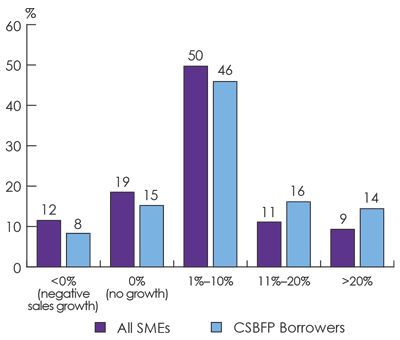
Source: Statistics Canada, Survey on Financing and Growth of Small and Medium Enterprises, 2014.
When asked which factor was a major obstacle to growth, over one quarter of CSBFP borrowers responded that they had difficulty maintaining sufficient cash flow and managing debt (Figure 2). With only 14 percent of all SMEs citing this as a serious barrier to growth, this may signify an increased need for cash financing among younger, less experienced, growth-oriented entrepreneurs in Canada. In general, CSBFP borrowers identified all obstacles to growth as being more severe than all SMEs. The least significant obstacles to growth were the availability of labour (CSBFP borrowers) and access to financing (all SMEs).
Figure 2: Major Obstacles to Growth (2014)
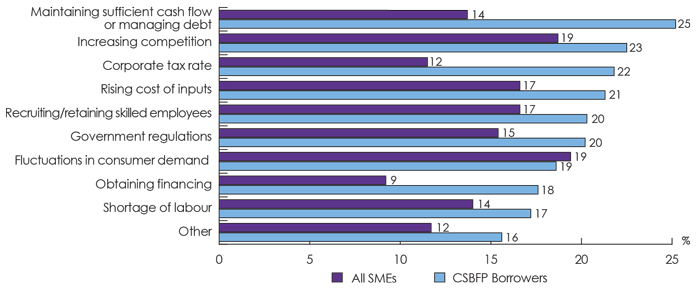
Note: Rounding of numbers results in discrepancy among some bars.
Source: Statistics Canada, Survey on Financing and Growth of Small and Medium Enterprises, 2014.
More than half of CSBFP borrowers identified themselves as innovators, having taken steps to innovate in at least one area of their business between 2011 and 2014 (Figure 3). CSBFP borrowers were stronger innovators across all four categories of innovation during the review period, with the most common innovation activity across both groups being product innovation. Thirty-seven percent of CSBFP borrowers and 26 percent of all SMEs indicated that they innovated a new or significantly improved good or service within the three-year period. Respondents indicated they were less likely to innovate with respect to the process or method by which they produce goods and services (process innovation) and in the area of organizational practices (organizational innovation).
Figure 3: Innovation Activity (2011–2014)
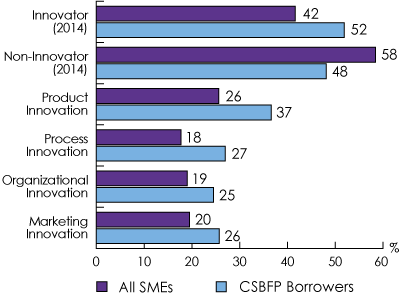
Source: Statistics Canada, Survey on Financing and Growth of Small and Medium Enterprises, 2014.
Although CSBFP borrowers recorded higher levels of innovation related to their businesses, all SMEs were more likely to own intellectual property. As of December 2014, 21 percent of all SMEs held at least one type of intellectual property compared with 17 percent of CSBFP borrowers. The most common form of intellectual property among all SMEs was non-disclosure agreements (12 percent), while registered trademarks (10 percent) were most common among CSBFP borrowers. These results reflect the fact that CSBFP borrowers are younger and highly concentrated in sectors that generally do not focus on development of intellectual property, such as accommodation and food services and retail trade.
In terms of sales destinations, the vast majority of CSBFP borrowers and all SMEs sold to customers within their municipality (Figure 4). The more established group of all SMEs was slightly more likely to conduct sales outside of their municipality, province and country. This can be explained by the fact that Canadian SMEs are highly concentrated in the accommodation and food services and retail trade sectors, which are brick and mortar in nature and predominantly service a customer base within a commutable distance. Roughly 7.0 percent of CSBFP borrowers and 11.8 percent of all SMEs engaged in export activity in 2014, a slight increase from 2011 levels.Footnote 10 This is a positive sign considering SMEs engaged in exporting generate higher sales, larger pre-tax profit margins and better returns on assets, on average, in comparison with non-exporters. As well, exporters are more research and development intensive and growth oriented.Footnote 11 This trend is likely due, in part, to growth in the importance of having an online presence. As SMEs become more engaged with online sales, this trend will likely continue to increase as there will be a stronger emphasis on doing business in the global marketplace.
Figure 4: Sales Destination (2014)

Source: Statistics Canada, Survey on Financing and Growth of Small and Medium Enterprises, 2014.
About 90 percent of respondents from both groups cited the local nature of their business as the reason why they did not export. Other issues, such as administrative obstacles, market knowledge, border knowledge and logistics, were not seen as major barriers to international markets by either group.
5. Industrial characteristics
Four industry sectors and one miscellaneous category accounted for three quarters of CSBFP loans by value (Table 2). In 2014–15, 37 percent of CSBFP borrowers were active in the accommodation and food services sector, which only represents about 2.1 percent of Canada's gross domestic product.Footnote 12
| Sector | Number of loans | Value of loans ($000) | Percentage of total value of loans |
|---|---|---|---|
| Source: Statistics Canada, Survey on Financing and Growth of Small and Medium Enterprises, 2014. | |||
| Accommodation and food services | 1,429 | 287,900 | 37% |
| Retail trade | 641 | 105,957 | 13% |
| Other services (except public administration) | 679 | 91,399 | 12% |
| Transportation and warehousing | 731 | 70,029 | 9% |
| Personal care services | 202 | 30,933 | 4% |
The concentration of borrowers in the accommodation and food services sector is a reflection of the high degree of risk involved in starting up an enterprise in this sector. According to the Office of the Superintendent of Bankruptcy Canada, accommodation and food services led all other sectors in 2015 with 5.8 insolvencies per 1,000 businesses.Footnote 13, Footnote 14 Retail trade, another risky sector, received 641 CSBFP loans in 2014–15, totalling almost $106 million, and reported 2.0 insolvencies per 1,000 businesses.
Since 1999–2000, the CSBFP has experienced an upward trend in lending to the accommodation and food services and retail trade sectors. Figure 5 illustrates the share of these sectors in CSBFP activity, which accounted for 50 percent of loan value and 40 percent of loan registrations in 2014–15. This represents an increase of 13 percentage points in loan value and 9 percentage points in loan numbers since 1999–2000.
Figure 5: Accommodation and Food Services and Retail Trade as a Share of all CSBFP Activity (1999–2015)
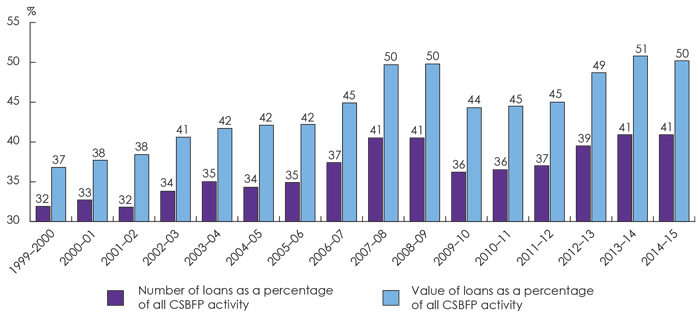
Note: Rounding of numbers results in discrepancy among some bars.
Source: CSBFP administrative data, 2016.
The data suggest that financial institutions consider business proposals from these sectors to be in a higher risk category, making them suitable candidates for the CSBFP—a program designed to provide partial coverage on loans that are on the edge of lenders' risk spectrums. This may also be a sign that the CSBFP's term loans are more closely aligned with the needs of brick and mortar establishments, whereas service-oriented enterprises may have a greater need for more flexible financing to address non-asset needs, such as research and development, marketing, wages, etc. For example, CSBFP loans in the information technology sector represented only 1.2 percent of total loan value in 2014–15, despite that sector accounting for 4.4 percent of Canada's GDP.Footnote 15
6. Financing
Data suggest that more and more Canadian SMEs are requesting external financing (Figure 6).Footnote 16 This is especially the case for CSBFP borrowers, who increased their requests for financing by 23 percentage points between 2007 and 2014, with nine out of ten firms applying for financing in 2014. Half of all SMEs, on the other hand, requested financing in 2014, an increase of 33 percentage points since 2007.
Figure 6: Requested External Financing in the Last 12 Months
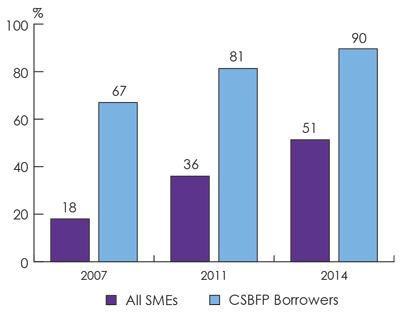
Source: Statistics Canada, Survey on Financing and Growth of Small and Medium Enterprises, 2014.
Personal financing was the most popular source of capital for both groups, with nearly 85 percent of all respondents indicating that they used personal assets to start up their businesses (Table 3). CSBFP borrowers were far more reliant on financial institutions as a source of financing, at 77 percent, compared with 45 percent of all SMEs.
| Source of financing | CSBFP Borrowers | All SMEs |
|---|---|---|
| Source: Statistics Canada, Survey on Financing and Growth of Small and Medium Enterprises, 2014. | ||
| Personal financing | 83% | 84% |
| Financial institutions | 77% | 45% |
| Friends or relatives | 23% | 17% |
| Government loans, grants, subsidies | 19% | 5% |
| Capital leasing | 16% | 11% |
| Trade credit | 15% | 19% |
| Retained earnings | 15% | 13% |
| Angel investors and venture capital | 4% | 2% |
| Other | 4% | 3% |
In terms of program usage and recognition, there was a fair degree of discrepancy between the findings of the Survey on Financing and Growth of Small and Medium Enterprises and the CSBFP Awareness and Satisfaction Study. The former found that only 19 percent of CSBFP borrowers recognized that they obtained financing from a government program despite the fact that they received financing through the CSBFP, which by definition is a government program. By contrast, the latter found that 41 percent of borrowers were aware of the program by its proper name, and more than 80 percent recognized it by its proper name or alternative names (e.g., Small Business Loans Program).Footnote 17
Debt FinancingFootnote 18
Data show that CSBFP borrowers requested and were approved for debt financing more often than all SMEs. This can be explained by the fact that CSBFP borrowers tend to request lower amounts of financing, which is easier for financial institutions to approve. Figure 7 shows that the average amount of debt financing requested by all SMEs in 2014 was $194,500, compared with almost $176,300 for CSBFP borrowers. In the end, both groups were authorized to receive around the same level of financing (about $167,500 for all SMEs and $162,300 for CSBFP borrowers).
Figure 7: Amount of Debt Financing (2014)
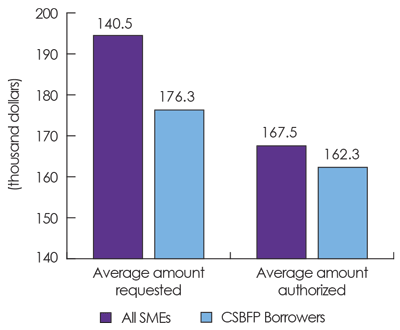
Source: Statistics Canada, Survey on Financing and Growth of Small and Medium Enterprises, 2014.
Table 4 confirms that in 2014 the most popular type of debt financing requested by CSBFP borrowers was term loans (55 percent), while all SMEs relied most frequently on cash financing (25 percent), such as lines of credit and credit card financing (financing tools that are not eligible under the CSBFP) over term loans (7 percent).
| Non-Residential Mortgage | Line of Credit | Term Loan | Credit Card | Overall | ||
|---|---|---|---|---|---|---|
| Source: Statistics Canada, Survey on Financing and Growth of Small and Medium Enterprises, 2014. | ||||||
| CSBFP Borrowers | Request rate | 14% | 37% | 55% | 39% | 83% |
| Approval rate | 94% | 82% | 99% | 88% | 97% | |
| All SMEs | Request rate | 4% | 14% | 7% | 11% | 28% |
| Approval rate | 80% | 77% | 86% | 88% | 85% | |
Approval rates for CSBFP borrowers and all SMEs were 97 percent and 85 percent,Footnote 19 respectively, which supports the Organisation for Economic Co-operation and Development's finding that Canada is among the world's leaders in ease of access to financing for entrepreneurs.Footnote 20
The number one reason why CSBFP borrowers were turned down for debt financing was because the project was deemed to be too risky. By comparison, insufficient sales / cash flow was the most common factor preventing all SMEs from accessing debt financing.
Over half of all respondents to the Survey on Financing and Growth of Small and Medium Enterprises relied on debt financing to meet their working capital needs (Figure 8).Footnote 21 Working capital is often used for paying suppliers, marketing, wages, and other short-term debt obligations and is not available through the CSBFP. All SMEs used debt financing to address working capital needs slightly more than CSBFP borrowers. On the other hand, CSBFP borrowers relied on debt financing more than all SMEs to cover costs for other machinery or equipment (49 percent), vehicles / rolling stock (28 percent), land and buildings (25 percent), computer hardware and software (20 percent) and entering a market (12 percent).
Figure 8: Intended Use of Debt Financing (2014)
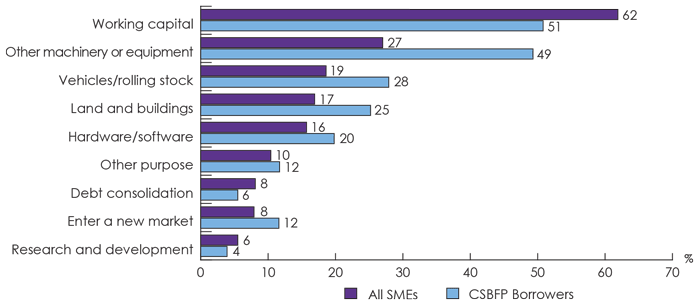
Source: Statistics Canada, Survey on Financing and Growth of Small and Medium Enterprises, 2014.
Equity financingFootnote 22
Figures 9 and 10 reveal a significant increase in the average amount of equity financing obtained from 2011 to 2014, suggesting that both CSBFP borrowers and all SMEs requested equity financing at lower rates, but in larger amounts, during the review period. Over the period, disbursements per business increased by 23 percent ($41,736) for CSBFP borrowers and 98 percent ($287,904) for all SMEs. This is an indication that small businesses are seeking higher levels of equity financing to provide them with cash and under more flexible terms than popular debt financing tools, such as term loans.
Figure 9: Equity Financing Obtained by CSBFP Borrowers and SMEs
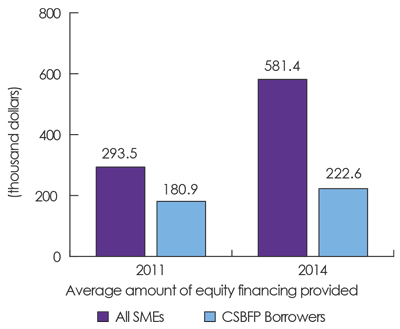
Source: Statistics Canada, Survey on Financing and Growth of Small and Medium Enterprises, 2014.
Figure 10: Equity Financing Request Rates
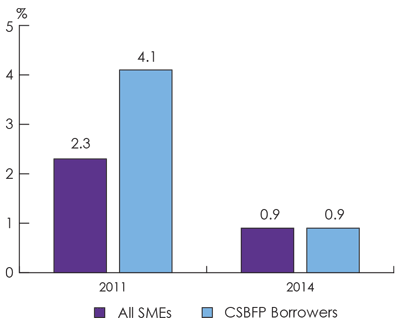
Source: Statistics Canada, Survey on Financing and Growth of Small and Medium Enterprises, 2014.
The rate at which firms have requested equity financing has declined from 2011 to 2014. In 2011, 4.1 percent of CSBFP borrowers and 2.3 percent of all SMEs requested equity financing. By 2014, these figures dropped precipitously to a 0.9-percent request rate across the board. Although the Survey on Financing and Growth of Small and Medium Enterprises did not collect data on equity financing approval rates, historical data from similar surveys, such as the 2013 Credit Condition Survey, suggest an approval rate of 75 to 85 percent.Footnote 23 This is in line with the debt financing approval rate for all SMEs of 85 percent.
LeaseFootnote 24 and trade creditFootnote 25 financing
CSBFP borrowers and all SMEs reported nearly identical request and approval rates for lease and trade credit financing (Figure 11). Only 8 percent of respondents requested lease financing, mostly for the purpose of renting other machinery or equipment. Approval rates were about 95 percent for each group. The average amount of lease financing authorized for all SMEs was $95,700 and $82,200 for CSBFP borrowers.
Figure 11: Lease and Trade Credit (2014)
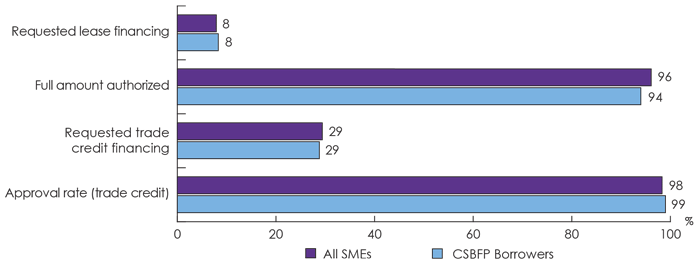
Note: Rounding of numbers results in discrepancy among some bars.
Source: Statistics Canada, Survey on Financing and Growth of Small and Medium Enterprises, 2014.
Similarly, 29 percent of CSBFP borrowers and all SMEs requested trade credit financing, with nearly all requests being approved. The average amount of trade credit authorized was $91,000 for all SMEs and $46,300 for CSBFP borrowers.
Conclusions
The CSBFP plays an important role in ensuring that Canadian SMEs have the necessary financing to grow and succeed in the marketplace. This study found that CSBFP loans are most likely to be disbursed to young, inexperienced owner/operators in Ontario or Quebec in the accommodation and food services or retail trade sectors.
Moreover, the evidence showed that CSBFP borrowers will play an important role in the economy moving forward as these firms were more growth oriented and more likely to innovate. Challenges remain in improving CSBFP enterprises' access to international markets and facilitating access to cash financing.
CSBFP borrowers relied on all types of debt financing, outpacing all SMEs in request and approval rates across several financing products. CSBFP borrowers and all SMEs were identical in requesting lease or trade credit financing in 2014.
In 2011, CSBFP borrowers had a slightly higher request rate for equity financing, but in 2014 CSBFP borrowers and all SMEs were identical in their request rates for equity financing.
In February 2016, the CSBFP made regulatory changes that increased Government of Canada coverage on real property loans from 10 to 15 years. The increase in term length goes hand in hand with legislative changes that were passed in June 2015 that increased the maximum loan amount under the program. While these changes are not expected to significantly change the profile of CSBFP borrowers, the average loan size will likely continue to increase faster than the rate of inflation as a result. For more information on CSBFP statistics, please visit the CSBFP Documentation Centre.
